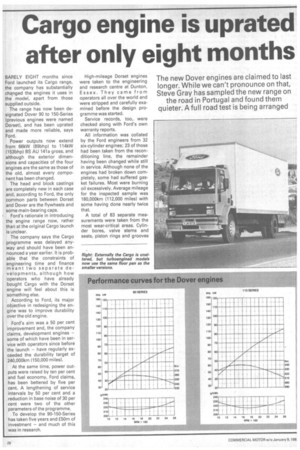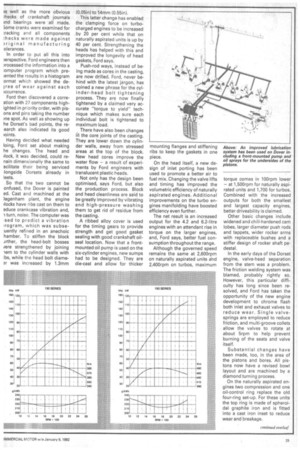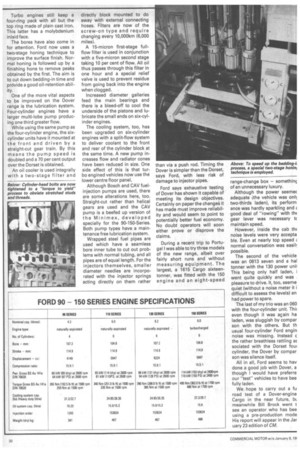Cargo engine is uprated after only eight months
Page 22

Page 23

Page 24

If you've noticed an error in this article please click here to report it so we can fix it.
The new Dover engines are claimed to last longer. While we can't pronounce on that, Steve Gray has sampled the new range on the road in Portugal and found them quieter. A full road test is being arranged
BARELY EIGHT months since Ford launched its Cargo range, the company has substantially changed the engines it uses in the model, apart from those supplied outside.
The range has now been designated Dover 90 to 150-Series (previous engines were named Dorset), and has been uprated and made more reliable, says Ford.
Power outputs now extend from 66kW (89bhp) to 114kW (153bhp) BS AU 141a gross, and although the exterior dimensions and capacities of the four engines are the same as those of the old, almost every component has been changed.
The head and block castings are completely new in each case and, according to Ford, the only common parts between Dorset and Dover are the flywheels and some main-bearing caps.
Ford's rationale in introducing the engine range now, rather than at the original Cargo launch is unclear.
The company says the Cargo programme was delayed anyway and should have been announced a year earlier. It is probable that the constraints of engineering time and finance meant two separate developments, although how operators who have already bought Cargo with the Dorset engine will feel about this is something else.
According to Ford, its major objective in redesigning the engine was to improve durability over the old engine.
Ford's aim was a 50 per cent improvement and, the company claims, development engines — some of which have been in service with operators since before the launch — have regularly exceeded the durability target of 240,000km (150,000 miles).
At the same time, power outputs were raised by ten per cent and fuel economy, Ford claims, has been bettered by five per cent. A lengthening of service intervals by 50 per cent and a reduction in base noise of 30 per cent were two of the other parameters of the programme.
To develop the 90-150-Series has taken five years and £50m of investment — and much of this was in research. High-mileage Dorset engines were taken to the engineering and research centre at Dunton, Essex. They came from operators all over the world and were stripped and carefully examined before the design programme was started.
Service records, too, were checked along with Ford's own warranty reports.
All information was collated by the Ford engineers from 32 six-cylinder engines; 23 of those had been taken from the reconditioning line, the remainder having been changed while still in service. Although none of the engines had broken down completely, some had suffered gasket failures. Most were burning oil excessively. Average mileage for the inspected sample was 180,000km (112,000 miles) with some having done nearly twice that.
A total of 83 separate measurements were taken from the most wear-critical areas. Cylinder bores, valve stems and seats, piston rings and grooves )s well as the more obvious :hecks of crankshaft journals Ind bearings were all made. iome cranks were examined for :racking and all components :hecks were made against )riginal manufacturing olerances.
In order to put all this into )erspective, Ford engineers then vocessed the information into a :omputer program which preented the results in a histogram ormat which showed the deIree of wear against each )ccurrence.
Ford then discovered a correation with 27 components highighted in priority order, with pisons and pins taking the number )ne spot. As well as showing up he Dorset's bad points, the reearch also indicated its good )oints.
Having decided what needed loing, Ford set about making he changes. The head and ilock, it was decided, could renain dimensionally the same to acilitate their being serviced longside Dorsets already in leets.
So that the two cannot be onfused, the Dover is painted ed. Cast and machined at the )agenham plant, the engine docks have ribs cast on them to educe crankcase vibration and, turn, noise. The computer was sed to predict a vibration program, which was subseuently refined in an anechoic hamber. To stiffen the block .ifther, the head-bolt bosses ;ere strengthened by joining lem to the cylinder walls with ibs, while the head bolt diame.1r was increased by 1.3mm (0.06in) to 14mm (0.55in).
This latter change has enabled the clamping force on turbocharged engines to be increased by 20 per cent while that on naturally aspirated units is up by 40 per cent. Strengthening the heads has helped with this and improved the longevity of head gaskets, Ford says.
Push-rod ways, instead of being made as cores in the casting, are now drilled. Ford, never behind with the latest jargon, has coined a new phrase for the cylinder-head bolt tightening process. They are now finally tightened by a claimed very accurate "torque to yield" technique which makes sure each individual bolt is tightened to maximum load.
There have also been changes ii the core joints of the casting. They are lower down the cylinder walls, away from stressed areas at the top of the block. New head cores improve the water flow — a result of experiments by Ford engineers with translucent plastic heads.
Not only has the design been optimised, says Ford, but also the production process. Block and head cleanliness are said to be greatly improved by vibrating and high-pressure washing them to get rid of residue from the casting.
A ribbed alloy cover is used for the timing gears to provide strength and get good gasket sealing with good crankshaft oilseal location. Now that a frontmounted oil pump is used on the six-cylinder engines, new sumps had to be designed. They are die-cast and allow for thicker mounting flanges and stiffening ribs to keep the gaskets in one piece.
On the head itself, a new design of inlet porting has been used to promote a better air to fuel mix. Changing the valve lifts and timing has improved the volumetric efficiency of naturally aspirated engines. Additional improvements on the turbo engines manifolding have boosted efficiency even further.
The net result is an increased output for the 4.2 and 6.2-litre engines with an attendant rise in torque on the larger engines, and, Ford says, better fuel consumption throughout the range.
Although the governed speed remains the same at 2,600rpm on naturally aspirated units a'nd 2,400rpm on turbos, maximum torque comes in 100rpm lower — at 1,500rpm for naturally aspirated units and 1,700 for turbos. Combined with the increased outputs for both the smallest and largest capacity engines, better driveability is claimed.
Other basic changes include widened and chill-hardened cam lobes, larger diameter push rods and tappets, wider rocker arms with replaceable bushes and a stiffer design of rocker shaft pedestal.
In the early days of the Dorset engine, valve-head separation from the stem was a problem. The friction welding system was blamed, probably rightly so. However, this particular difficulty has long since been resolved, and Ford has taken the opportunity of the new engine development to chrome flash both inlet and exhaust valves to reduce wear. Single valvesprings are employed to reduce friction, and multi-groove collets allow the valves to rotate at about 5rpm to help prevent burning of the seats and valve itself.
Substantial changes have been made, too, in the area of the pistons and bores. All pistons now have a revised bowl layout and are machined by a diamond turning process.
On the naturally aspirated engines two compression and one oil-control ring replace the old four-ring set-up. For these units the top ring is made of spheroidal graphite iron and is fitted into a cast iron inset to reduce wear and breakage. Turbo engines still keep a four-ring pack with all but the top ring made of plain cast iron. This latter has a molybdenium inlaid face.
The bores have also come in for attention. Ford now uses a two-stage honing technique to improve the surface finish. Normal honing is followed up by a finishing hone to remove peaks obtained by the first. The aim is to cut down bedding-in time and provide a good oil-retention abil-. ity.
One of the more vital aspects to be improved on the Dover range is the lubrication system. Four-cylinder engines have a larger multi-lobe pump producing one third greater flow.
While using the same pump as the four-cylinder engine, the sixcylinder units have it mounted at the front and driven by a straight-cut gear train. By this means the pump speed is doubled and a 70 per cent output over the Dorset is obtained.
An oil cooler is used integrally with a two-stage filter and directly block mounted to do away with external connecting hoses. Filters are now of the screw-on type and require changing every 10,000km (6,000 miles).
A 15-micron first-stage fullflow filter is used in conjunction with a five-micron second stage taking 10 per cent of flow. All oil thus passes through this filter in one hour and a special relief valve is used to prevent residue from going back into the engine when clogged.
Increased diameter galleries feed the main bearings and there is a bleed-off to cool the underside of the pistons and lubricate the small ends on six-cylinder engines.
The cooling system, too, has been upgraded on six-cylinder engines with a split-flow system to deliver coolant to the front and rear of the cylinder block at the same time. A new pump increases flow and radiator cones have been reduced in size. One side effect of this is that turbo engined vehicles now use the lower centre floor panel.
Although Bosch and CAV fuelinjection pumps are used, there are some alterations here, too. Straight-cut rather than helical gears are used and the CAV pump is a beefed up version oi the Minimex, developed specially for the 90-150-Series. Both pump types have a maintenance free lubrication system.
Wrapped steel fuel pipes are used which have a seamless bore inner tube to cut out problems with normal tubing, and all pipes are of equal length. For the injectors themselves, smaller diameter needles are incorporated with the injector springs acting directly on them rather than via a push rod. Timing the Dover is simpler than the Dorset, says Ford, with less risk of damage to injector pipes.
Ford says exhaustive testing of Dover has shown it capable of meeting its design objectives. Certainly on paper the changee it has made must improve reliability and would seem to point to potentially better fuel economy. No doubt operators will soon either prove or disprove the claims.
During a recent trip to Portugal I was able to try three models of the new range, albeit over fairly short runs and without measuring equipment. The largest, a 1615 Cargo sixteentonner, was fitted with the 150 engine and an eight-speed range-change box — somethinc of an unnecessary luxury.
Although the power seemec adequate the vehicle was ortiN two-thirds laden), its perform ance was hardly sparkling and good deal of "rowing" with th( gear lever was necessary tc maintain speed.
However, inside the cab th( noise levels were very accepta ble. Even at nearly top speed normal conversation was easil, possible.
The second of the vehicle was an 0813 seven and a ha) tonner with the 130 power unit This being only half laden, I went quite quickly and was pleasure to drive. It, too, seeme quiet (without a noise meter it i difficult to assess the levels) an had power to spare.
The last of my trio was an 060 with the four-cylinder unit. Thit even though it was again ha laden, was sluggish by compar son with the others. But th usual four-cylinder Ford engin noise was missing. Instead c the rather breathless rattling at sociated with the Dorset foul cylinder, the Dover by compar son was silence itself.
All in all, Ford seems to hay done a good job with Dover, a though I would have preferre our "test" vehicles to have bee fully laden.
We hope to carry out a fu road test of a Dover-engine Cargo in the near future, Ix meanwhile Bill Brock went t see an operator who has bee using a pre-production mode His report will appear in the Jar uary 23 edition of CM.










































